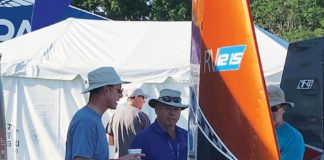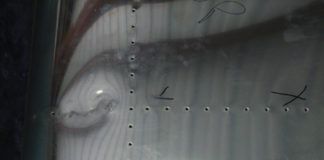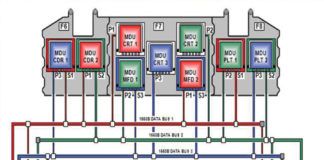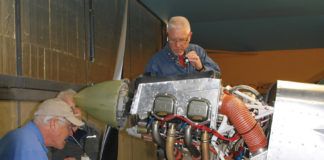
A heads up display can now be part your a GRT Avionics equipped airplane for as little as $300. GRT’s pursuit of heads up display technology has led to support for the Hudly automotive after-market heads up display. Graphics optimizations in the GRT remote app, combined with the impressive readability and value of the Hudly have resulted in the first practical heads up display for experimental and general aviation (certified) airplanes.
- Aircraft mounted heads-up display
- Sunlight-Readable Color Symbology
- Primary Flight Data
- Flight Director and HSI Guidance
- Lateral/Vertical Deviation for Approach
- Stall warning and all other features of GRT Vision App
Installation is a matter of mounting the projector and the combiner glass with double-sided foam tape. The GRT Vision App allows the projector to be mounted above, or below the combiner glass, and includes corrections for optical distortions. Video is provided to the HUD via a MHL-compatible android device, such as a cell phone or tablet.
Flying a precise approach into a short field previously required careful judgement of your approach path, accurately controlling speed, while maintaining visual separation from obstacles and terrain. This forced the pilot to alternate between views inside and outside the airplane. Even with our famous synthetic approach guidance, precision approach path information was only a heads-down option.
With the HUD, flying a precise approach becomes easy. Activate the synthetic approach on the EFIS, and the HUD provides flight director guidance (just put the little circle in the flight path marker). IFR? It works the same, with the raw ILS/GPS LPV data provided on scales while the flight director guides you in.
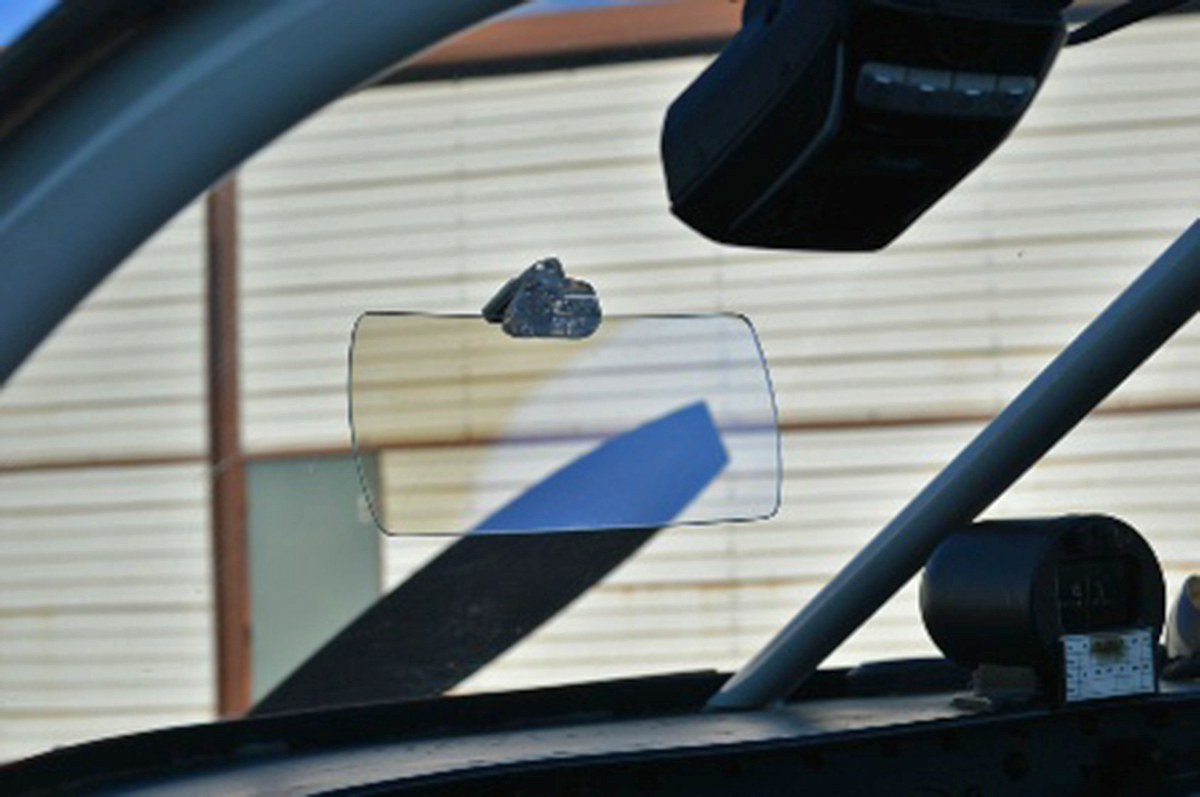
How to buy
1. Purchase a Hudly from gethudly.com
2. Install GRT Remote App on your MHL compatible android device. Don’t have one? We recommend a Samsung S3, available on Ebay.com for well under $100.
3. The GRT HUD compatibility option is free with any GRT EFIS purchased during AirVenture. A five-hour trial period is provided for existing GRT users.
Zero Risk
Try one today! Five hour free HUD trial is provided for any compatible GRT EFIS. See gethudly.com for details of 30-day return policy.
AirVenture Special
Purchase any GRT EFIS and the GRT Vision/HUD Compatibility is included.
Questions and Answers with Greg Toman, GRT founder, about the new Heads-Up Display
Q. How is it in sunlight? With sunglasses?
Ans. Effortless to read in bright light. In fact, superior to any heads down display. When flying into the sun, the instrument panel is darker than the bright sky, and much closer than the HUD image, making for a more difficult adjustment for your eyes. Looking into the cockpit when on approach feel cumbersome by comparison. I much prefer the HUD data when landing into the sun. The brightness of the HUD adjusts automatically according to the ambient light so it is not overwhelming in other conditions..
Sunglasses have no effect on the readability.
Q. Where does the image appear to be focused?
Ans. Ideally, the image would be focused near infinity, but it is not. It might be something like 6 or 8 feet out, so you will have to change your focus to see either the HUD or the approaching runway, and you can not see both at the same time. Not ideal, and this was as I anticipated. However, I did not anticipate that this imperfection would turn out be of small significance with respect to the ability to use the data. The bigger effect, although also small, was to slightly confuse the view when looking through the HUD into the distance. You can simulate this effect by looking at a distant object and holding with you finger in front of you.
Q. What is the other imperfection?
Ans. The combiner glass vibrates at some engine RPMs. It was held in place only by a small piece of double-sided foam tape. Even with the shaking at some RPMs, it is usable, just not ideal. I don’t know who will solve this first…us or our customer base. It should be an easy problem, and even with the shaking, I want it.
Q. Do you really need a HUD in a VFR airplane?
Ans. No, but for $300, why wouldn’t you? I found it much easier to monitor my airspeed on approach, and keep that, and my glide path, precisely controlled. My second landing with it was into an 1850′ runway with the company RV-6a, and it felt easy. My third was over the trees into my home field, with the synthetic approach keeping me honest on my glide path, and once again, it was low-stress and precise. Maybe I got lucky, but more likely it was the ease at which I could sense everything at once with my head always out the window.
There is no doubt it will benefit safety also. For example, as you approach stall, a red pitch limit indicator moves down from the top of the screen, and shows you that you are approaching stall. In fact, you can see how many degrees of AOA you are from stalling. Also, with the HUD displaying the synthetic approach glideslope, it is difficult to shallow up the approach without being aware of it. I see many pilots shallow their approach near the runway, probably because it makes the flare easier, but risks colliding with obstacles. There were two fatal accidents caused by this near Grand Rapids in recent years. The HUD allows you to monitor your approach more precisely and easily.
Q. Will the HUD work in IFR?
Ans. Yes. Lateral and vertical deviations are displayed on it when they are active, from the synthetic approach, ILS, or GPS approach, in addition to primary flight data.
Q. How long does it take to adapt to it?
Ans. For me, practically zero time. I was skeptical of this before the first flight, but on the takeoff roll I found myself using the airspeed, and climbing out with my head out the window. I did not look into the cockpit for primary flight data the entire flight.
Q. Is the combiner glass hard to see through?
No. It is glass (not plastic), and has optical coatings. Very well done. Optically beautiful. I suspect it has anti-reflective coatings on the far surface, and coatings to reflect the RGB of the projector on the near surface. The images on the HUD do have some effect on your ability to look forward, as I mentioned above, but it was not a problem. On my third flight, while approaching the airport, I spotted an airplane back taxing on the runway, that I had not heard on the radio (I realize now I had forgot to tune my com radio to the CTAF, so it was my fault). In any event, I spotted the airplane without difficulty, and keep an eye on it, even with the HUD positioned directly in front of me.
Q. If I make my own mount for the combiner glass, should it allow the combiner glass to be swung out of the way?
Ans. Maybe. My second landing with the HUD was at an 1800′ runway (61D – runway 27), and into the sun, no wind, in an RV-6A. This is a bit of a stressful approach for me, so at first I had the urge to go back to what I was used to…no HUD combiner glass in front of me, and the usual view I was accustomed to. However, I continued the approach with the HUD, and it was uneventful. So for me, I don’t care (based on my limited experience so far) if my combiner glass could be swung out of the way or not.
Q. How was it at night?
Ans. I did not fly or land at night with it yet. I did land about 20 minutes after sunset, and it was fine. The brightness adjusts automatically, and it seemed ideal.
Q. The projector looks a bit bulky and seems it could block a significant amount of
your forward view, especially in the RV-6. Was that a problem?
Ans. I had many concerns before I flew it, and this was one of them. As it turned out, it blocks very little area (maybe because we have two eyes spaced apart more than the width of the projector?) and was absolutely a non-issue.
Q. What about reflections off the combiner glass, especially when the sun is behind you?
Ans. This was another on my list of concerns, and it also was a non-issue. The projector blocks the sunlight when it comes in at an angle that would reflect into your eyes, so it can’t reflect off the combiner glass. If I worked at it, I could momentarily get some reflection of the sunlight, because the projector does not perfectly block the entire combiner, but this is very unlikely to be a problem in actual use.
Q. Is the HUD useful in cruise?
Ans. Absolutely. It makes everything easier. In fact, it could make things too easy!
Q. Does the HUD symbology, such as the horizon line, match up with the real world?
Ans. Not exactly. Because the field of view of the HUD is small (about 5-7 degrees vertically), the app does not attempt to match the HUD view to the outside world view. In a fighter plane, where you are concerned with weapons targeting, this would be important, and yes, it would be nice if we could draw an outline around the runway, keep the horizon line on the actual horizon, etc., but is probably not practical given the small field of view and the HUD’s focus. This compromise was another of those concerns that proved unfounded. Yes, an optically perfect HUD would be ideal, but this compromise was not a big deal, and had little impact on the usefulness of this display.
Q. Would a larger HUD be preferred?
Ans. This was another concern I had that proved to be unfounded. Yes, the field of view of the Hudly is a small part of the world around you, but it seemed to be the ideal size. If the HUD was optically perfect (like that in a military airplane) I might prefer it to be larger. Since it isn’t optically perfect, having a view around it was nice. For example, in the flare, I found that I was looking under the combiner glass to sense the ground at touchdown. The Hudly is certainly large enough to show a great deal of information, and is easily readable. I am quite content with it size.
Q. Will the HUD work with my prescription glasses?
Ans. Yes. I am slightly near-sighted, and the image is appears to be 6-8 feet in front of you, but I had no problem flying without my glasses. Since I am near-sighted, and because the image appear to be 6-8 feet away, I could see the hud a little better with my glasses on, but that is because of my eye sight
Q. How does the Hudly compare with the Android glasses?
Ans. The android glasses (Epson BT-200/300) work well, are sunlight readable, and provide a higher resolution image than the Hudly. The android glasses are not compatible with eyeglasses, although prescription lenses can be added to them. This can be a problem for many. While I do not need prescription lenses, I found the android glasses took a bit of effort to manage (getting them out, organizing the cables, turning them on, selecting the app, putting them away). Once you got past that, and had them on, they were reasonable comfortable, but not as comfortable as my sun glasses. They could affect the seal on my noise-canceling headsets also.
For me, the HUD was a dramatic improvement in convenience, and I also like the image being “attached” to the airplane, as compared to my head. The resolution is more than adequate. I suspect that 95% of users will find this to be true, and a small percentage will still prefer the glasses. For me, it is a no-brainer. Give me the HUD! I can’t imagine flying without it already.
Q. How do I use the HUD in my certified airplane?
Ans. It must be used with the Mini-GA. This instrument will provide the app with the data it needs to drive the HUD. A remote air data module will be available for use with the Mini-GA by October 1,2017.










